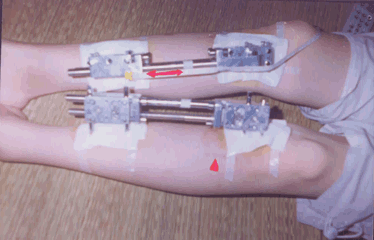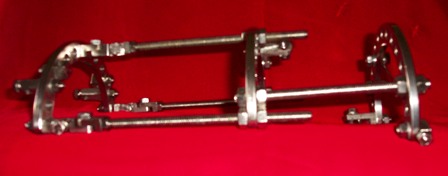I was again doing research for another article, specifically the one for the internal ISKD method and I started to wonder whether It was possible for the height increase researchers on here to develop a better biomedical device to be used to stretch out the long bones.
Here are all the types of medical devices out there right now, all used in the surgical method for limb lengthening. The resource used to find all this information below was from the Short Support Website located HERE
1. Albizzia is also called GEN for Gradual Elongation over intramedullary Nail and is a variation of Internal Lengthening Over Nails. The device is sping loaded. The rotation of the patient’s lower extremity creates the distraction with an audible “click.”
2. Bliskunov’s method
3. The Fitbone® device – the only device that uses a powered system to lengthen the legs. The bones of the leg (Tibia and/or Femur) are cut and the intramedullary telescoping nail is implanted in the bone marrow of each bone. Each end of the telescope nail is attached to each end of the cut bone. The nail is connected to an induction receiver that is placed just under the skin. An external control unit powers the telescope nail though the induction plate. A similar technique has been used to power artificial hearts.
4. Intramedullary Skeletal Kinetic Distractor (ISKD) – uses a kinetic clutch mechanism to lengthen the leg. One segment of a rod is screwed onto another and the whole rod is inserted into the patient’s bone. When the patient rotates his or her leg, the lower segment rotates over the upper one, like screwing a bolt out of a nut, and the rod lengthens, expanding the leg.
5. Lengthening Over Nails (LON) – a metal rod is inserted into the central cavity (intramedullary) of the lower legs (the tibia bone), and then the external fixator device is attached to the bone. As the limb is lengthened, one end of the bone slides over the rod and new bone is grown around it. When the bone is fully lengthened, the external device is removed and the rod is surgically attached to each bone segment. During bone strengthening, the rod provides support instead of the more uncomfortable and unwieldy External Fixator Device. At the end of the Strengthening phase, a second operation is performed to remove the metal rod.
6. Micro-wound – uses a fixative clip instead of an Ilizarov fixator. The fixator clip covers just one side of the leg and appears to be more comfortable than the Ilizarov fixator which completely surrounds the leg.
7. Precice™ – uses non-invasive adjustable intramedullary rods or bone plates to lengthen long-bones (e.g., femur, tibia). There are no open wounds. Lengthening is achieved through an External Remote Controller (ERC). The “ERC” is a portable, hand held unit that uses permanent magnets to automatically modify the length of the implant through the touch of a switch
8. Salamehfix – a hinged External Fixation System. It is an arc system rather than a circular system and consists of three small arcs. The arcs are not the same diameter so the system can take the shape of leg. The entrance of screws and wires are in minimally painful regions so it’s more tolerable, provides for stable fixation and allows early full weight bearing. The small size of the system allows clothing to be worn over it with full mobility of nearby joints.
9. Original Ilizarov External Device
Me: It really is absolutely amazing to see what type of technology has been developed in the last 40 years ever since the Ilizarov fixator first came on the scene and allow people who had uneven limbs to get medical treatments fot their attention. Very quickly, the short stature community realized the potential of this device and got the surgeons to use them to make people taller.
Dr. Paley who has been doing the limb lengthening surgery for over 30 years now have come up with two big innovations on his own just from doing the surgeries and from experiences, seeing how they can be improved on.
In my opinion however ,the devices that are currently out can be made even better and improved on in the design. So far there is 9 different types of devices, but they all operate on the exact same type of principles. First, you cut open the bone you want to lengthen. Then you put something that can hold the two bones a small distance apart from each other. The bone ends starts to heal, and you slow move the bone parts further and further apart as the bones heal The bones thus increase. The muscles around them are also stretched out in the process.
Getting back to the original issue, can we design a better device? I think we can. Here is my proposition.
The first principle to focus on is to make the device as non-invasive as possible. In my opinion, that means that after the bone has increased and healed it’s over, a quick trip to the doctor should mean the removal of the device and the bones will need little recovery after that.
The 2nd principle is to design a device that is strong but lightweight enough to hold up to the rigors of the limb bending and movement. The device can not collapse to the weight exerted on it by the human bones.
The 3rd principle is to create a design that can allow the full support of the leg. The leg MUST be completely fixed in place or the bones might turn or tiwst incorrectly leading to improper healing and the eventual bone regrowing into something crooked or stunted.
My idea for the device is a combination of the Microwound device used by Dr. Helong Bai and the Salamehfix device used by Prof. Ghassan Salameh. I will write up the new design in a future article. That however probably won’t come out for another 4-6 months, mainly because I want to study all of the devices that are out now and I haven’t done that yet.



Pingback: Complete List Of Posts - |